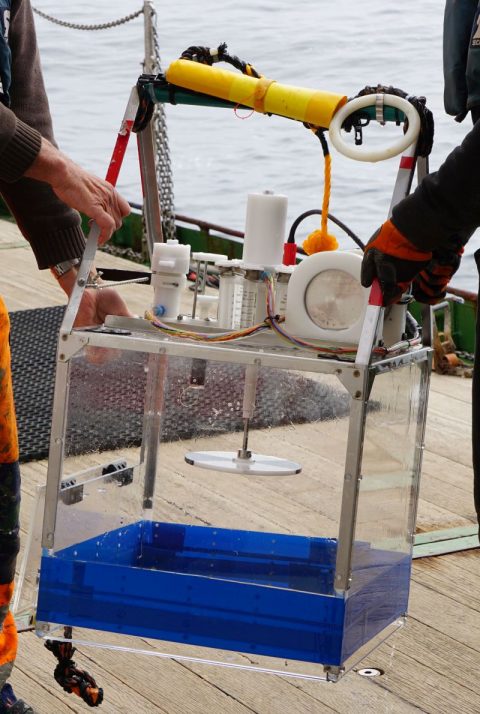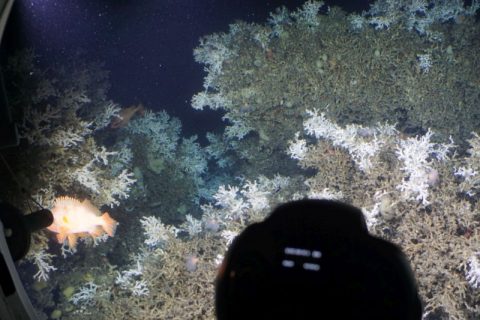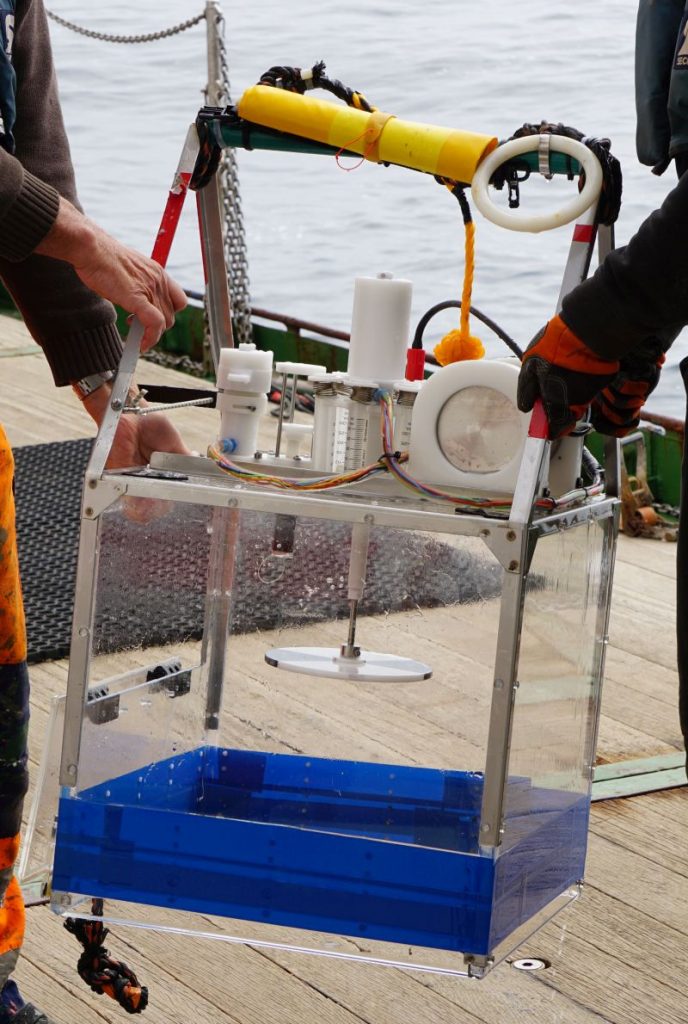[English version below]
In diesem Blog möchten wir euch einen weiteren Teil unserer wissenschaftlichen Ausrüstung vorstellen, unsere CUBEs. Wie auf dem Titelbild und auf dem Bild unten zu erkennen ist, handelt es sich hierbei um große, würfelförmige Boxen, ausgestattet mit einer Reihe von Geräten. Sie sind dafür gemacht, sie mit ihrer Öffnung auf der Unterseite auf den Meeresboden zu stellen. Nur, wozu?

Das CUBE-System. Foto: Janina Büscher
Wissenschaftler lieben es seit jeher, zu zählen und sämtlichen Vorgängen in der Natur Zahlen zuzuordnen. Wir möchten nicht nur wissen, wie viele Organismen in einem Kaltwasserkorallenriff leben, sondern auch was diese Organismen zum Leben brauchen. Nur wenn wir herausfinden, wieviel Nahrung sie benötigen, können wir vorhersagen, in welchen Bereichen der schier unendlichen Tiefsee wir weitere, noch unbekannte Riffe finden können – und ob es sie dort auch noch in Zukunft geben wird.

Lebende Korallen (weiß) mit abgestorbener Riffbasis darunter, in welcher viele viele Organismen leben und Schutz und Futter finden. Foto: Janina Büscher
Ein Kaltwasserkorallenriff besteht bei weitem nicht nur aus den Korallen selbst: Wenn eine Korallenkolonie vom Meeresboden nach oben wächst, in Richtung der Strömungen, die sie mit Nahrung versorgt, lässt sie unter sich eine dicke Schicht abgestorbener Korallenskelette zurück. In diesem Labyrinth aus „nackten“ Korallenskeletten finden unzählige Lebewesen Schutz und einen relativ stabilen Untergrund, auf dem sie sich ansiedeln und gedeihen können. Dies ist der Teil des Kaltwasserkorallenriffs mit der höchsten Biodiversität, und zusammen mit den lebenden Korallen bezeichnen wir diese Gemeinschaft als Kaltwasserkorallengemeinschaft.
Sandra Maier
(NIOZ)
——————————————————————————————————————————————————————————-
Let us introduce another piece of our scientific equipment to you, our CUBE systems. As you can see in the picture, the CUBEs are large cubic boxes with a lot of fancy (and heavy) equipment on top, and an opening on the bottom, designed to stand on the seafloor. But what do we need them for?

The CUBE. Picture: Janina Büscher
Well, scientists love to count and assign numbers. We like to not only count the number of all those different, beautiful organisms that we can find in the cold-water coral reefs, but we also like to know what they need to make their living. Only if we find out how much food they require, we will be able to predict in which places in the vast deep sea they can occur, and also if they will still be able to occur there in the future…
The cold-water coral community does by no means only consist of the corals themselves: When a coral colony grows upwards from the seafloor, towards the food-delivering currents, it leaves behind a thick layer of bare coral skeletons underneath, where the coral itself has naturally died off. In this labyrinth of bare coral framework, a variety of different animals finds shelter and a solid, relatively stable substrate to grow on. This is the part of the cold-water coral reef where we find the highest biodiversity, and together with the live corals on top, we consider it the reef community.

Live corals (white) with dead coral basis underneath with a lot of different organisms living in the protected and sheltered dead coral framework. Foto: Janina Büscher
To find out the amount of food which this cold-water coral community needs, a good measure is its respiration – the process that all living organisms use to convert the nutrients of their food into useful energy for their living.
Which brings us back to our CUBEs. Those large chambers can be placed with their bottom-opening over a fragment of live coral and the associated community, and like this seal it off from the surrounding water for one day. Within the water in the CUBEs, a so-called optode, an oxygen-measurement device, measures the oxygen consumption of the reef community, from which we can later calculate its respiration. The CUBE is also equipped with syringes that sample the water within the CUBE at pre-programmed time intervals, and allow us to determine the production of waste products of the cold-water community.
Sounds easy – follow our next posts to find out together with us if the CUBE deployment in the deep sea with the submersible JAGO turns out to be as easy…
Sandra Maier
(NIOZ)
